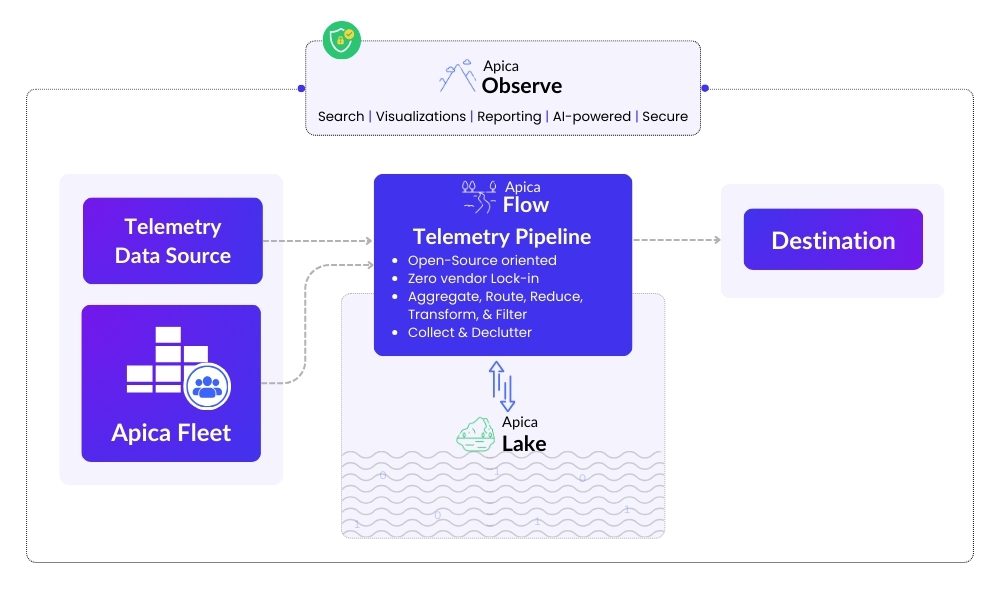Fleet management is a derivative term. Originally used in the automotive industry, it’s now used in a span of domains. It’s being used in data telemetry since the introduction of OpAmp, which is a part of the Open Telemetry project.
Now, fleet management has broader implications. It simplifies telemetry data collection by automating agent deployment, and configuration, and providing insights into the real-time health and performance of your sprawling agent infrastructure. Additionally, with centralized control, you can run a more stable infrastructure and eliminate config drift.
Apica has tapped into the potential of fleet management and engineered an integrated, vendor-agnostic fleet management solution for modern data management.
In this blog, we will explore what fleet management is in-depth, what are the major challenges, key features of Apica Fleet Management and how it can streamline your telemetry pipeline.
What is Fleet Management?
In telemetry, “fleets” refer to groups of data collection agents or collectors deployed across various hosts and environments within an organization. These agents gather telemetry data—such as metrics, logs, and traces—from different parts of a distributed system to provide comprehensive observability.
Fleet Data Management upgrades traditional telemetry from a static system to a dynamic, adaptable solution tailored to your specific operational requirements. It offers a sophisticated approach to data collection, focusing on efficiency and flexibility.
Fleet management is gaining traction in OpenTelemetry and other areas due to its ability to provide scalable, centralized, and secure management of telemetry agents. This ensures that all telemetry agents or collectors are functioning correctly, are up to date, and are properly configured, making it a critical component of modern IT infrastructure.
The Challenges with Fleet Management
As distributed environments expand in size and complexity, managing the deployment of telemetry agents across diverse systems becomes increasingly challenging.
Fleet Management is a solution designed to efficiently handle the administration, maintenance, and operation of telemetry agents in large-scale, intricate environments.
However, despite its advantages, fleet management faces significant hurdles in the modern telemetry, including:
- Data Overload: Handling and processing the immense volumes of telemetry data generated by numerous agents can be overwhelming.
- Scalability: Ensuring the system scales effectively as the number of agents and data volume increase, without losing performance or reliability.
- Integration: Seamlessly connecting with existing IT infrastructure, tools, and platforms, including various APM and monitoring solutions.
- Security: Safeguarding sensitive data collected by telemetry agents and ensuring secure communication between agents and management systems.
- Compliance: Meeting regulatory requirements for data collection, storage, and transmission, which can differ across regions and industries.
- Real-Time Processing: Providing real-time data analysis and insights to support prompt decision-making and issue resolution.
- Cost Management: Managing the costs associated with deploying, maintaining, and scaling telemetry agents and the supporting infrastructure.
Along with these challenges, the static data collection method poses the following challenges:
Inefficiency
Static data collection methods are outdated in today’s fast-paced digital environment. They lack the agility required to respond to rapid changes, leading to delays and missed opportunities for optimization.
High Costs
Collecting data indiscriminately can lead to excessive and unnecessary expenses. Without a targeted approach, resources are wasted on gathering and storing irrelevant data.
Rigid Configuration
Traditional telemetry systems often lack the flexibility needed to adapt to different operational contexts. This rigidity can lead to configuration errors and reduced system performance.
Vendor Lock-In
Relying on specific telemetry solutions can limit your options and hinder your ability to switch to more efficient or cost-effective alternatives. This dependency can stifle innovation and adaptability.
How Apica Fleet Management streamlines your Telemetry Pipeline

The Apica fleet management solution takes control of your telemetry with point-and-click ease and redefines your observability strategy. With a wide range of integrations, an exhaustive list of support for data types, and a reliable infrastructure, it parallels the modern data challenges. The following are the spaces where Apica Fleet Management delivers.
Dynamic Scalability
Automatically scales data collection efforts up or down based on real-time environmental factors, ensuring optimal use of resources. This means that during peak usage times, the system can increase data collection to capture all necessary telemetry while scaling back during quieter periods to save on resources and costs.
Lifecycle Integration
Enables centralized control over agent configurations and software versions, making it easy to roll out updates, patches, or new features. This integration streamlines the maintenance process, ensuring all agents are up-to-date and operating efficiently without the need for manual intervention on each agent.
Effortless Configuration Management
Provides an intuitive interface for managing agent configurations, reducing the likelihood of errors and enhancing overall system adaptability. This simplification allows IT teams to quickly adjust settings as needed without extensive training or risk of misconfiguration, leading to more reliable performance.
Why Apica Fleet Management?

Apica Fleet Management offers multiple benefits to streamline and optimize diverse telemetry agents, ensuring seamless integration, consistent configurations, and centralized control, in the following ways:
Diverse Agent Support
A wide range of agents, such as OpenTelemetry Collector, Fluent-bit, Telegraf, and others, to avoid vendor lock-in, and fully support OTel standards.
Hybrid Agent Management
The BYOA (Bring Your Own Agent) strategy ensures smooth integration across various agent types. Centralized Control Streamline the setup, updating, and maintenance of telemetry agents for top-notch security and efficiency.
Eliminate Configuration Drift
Deploy configurations consistently with tools to correct any discrepancies, boosting system dependability and performance.
TL; DR
- Fleet management: Originally from the automotive industry, now used in data telemetry for managing large-scale deployments of telemetry agents.
- Automation and Insights: Simplifies data collection by automating agent deployment and configuration, providing real-time health and performance insights.
- Centralized Control: Ensures stable infrastructure and eliminates configuration drift.
- Apica’s Solution: Offers a vendor-agnostic, integrated fleet management solution for modern data management.
Schedule a Demo
Ready to see how Apica Fleet Management can transform your telemetry pipeline? Schedule a demo today to explore our powerful solutions in action.
Find complete details in the Press Release.









